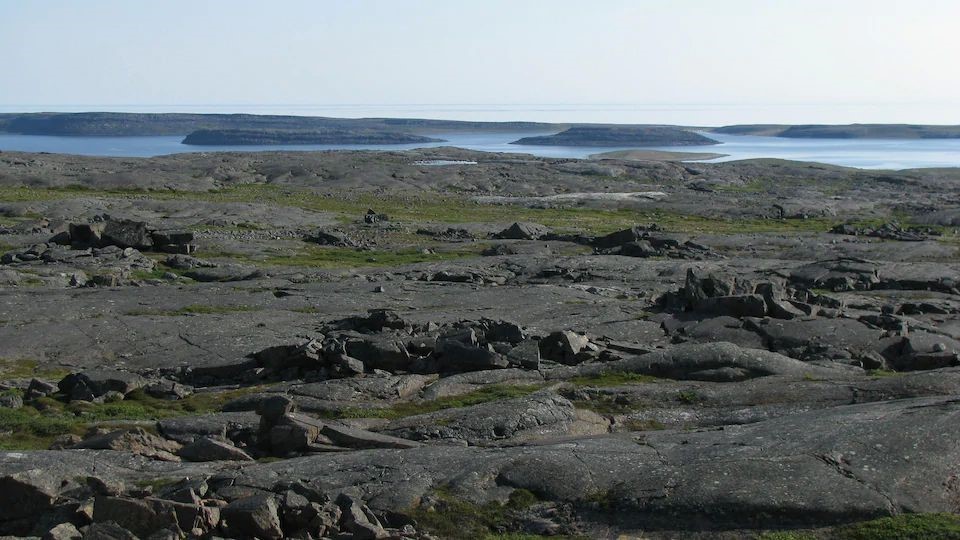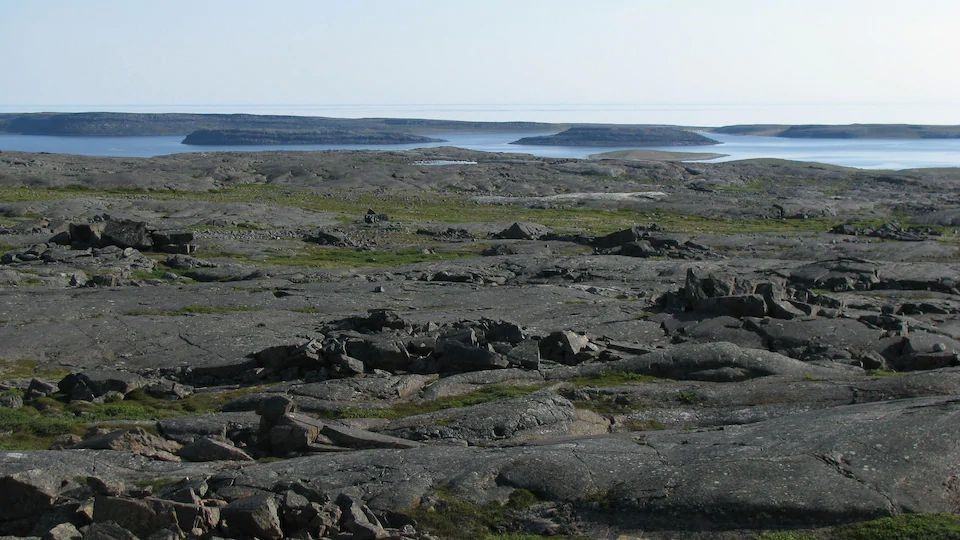
DISCLAIMER: This English version is translated from the original French. In case of any discrepancy, the French version shall prevail.
| Author: | Berclaz et al., 2003 |
| Age: | Eoarchean |
| Stratotype: | None |
| Type area: | Innuksuac River area (NTS sheet 34K05) |
| Geological province: | Superior Province |
| Geological subdivision: | Minto Subprovince |
| Lithology: | Volcano-sedimentary rocks |
| Type: | Lithodemic |
| Rank: | Lithodeme |
| Status: | Formal |
| Use: | Active |
None
Background
The volcano-sedimentary sequence was first identified and described by Lee (1965) near Marsouin Gulch, on the shores of Hudson Bay (Simard, 2008). Although they did not define the unit at the 1:1 000 000 scale, Stevenson et al. (1969) nevertheless plotted the contours of this granitic-predominant unit showing marked foliation and derived from various lithologies in this area (sedimentary rocks, volcanic rocks, hornblende-biotite gneiss, metagabbro and iron formations). Simard et al. (2003) later named it “Porpoise Cove Belt” and included it in the Innuksuac Complex, a unit composed mainly of amphibolite and paragneiss lenses (Simard, 2008). Dating of a felsic rock in the Porpoise Cove Belt yielded a very ancient age of 3825 ±16 Ma (Simard et al., 2008). As a result, detailed work was carried out on this volcano-sedimentary sequence by Berclaz et al. (2003), which renamed it the Nuvvuagittuq Belt. Simard et al. (2008) excluded the Nuvvuagittuq Belt from the Innuksuac Complex because of its lithological characteristics and its very ancient age.
The origin of the name is not known, but could be linked to the name of a lake in the area, Lake Nuvvuagittuup Tasinga.
Description
The Nuvvuagittuq Belt consists of various lithologies affected by complex polyphase tectonics. The following description is taken from Simard et al. (2003), Simard et al. (2008) and Simard (2008). Amphibolite is the dominant lithology of the belt. It forms sequences several hundred metres thick, containing decimetric to metric layers with varying textures. The Nuvvuagittuq Belt consists of three lobes. A first lobe consists of: 1) amphibolite associated with iron formations and ultramafic sills; 2) mafic to felsic tuff and paragneiss associated with polymictic conglomerate and quartzite; 3) various schists; 4) gabbro dykes or sills; and 5) heterogeneous, gneissic to migmatitic tonalite. The other two lobes are separated from the first by a mylonitic zone. These two lobes are mainly composed of foliated to banded amphibolite. They are composed of green hornblende elongated in foliation and quite saussuritized and sericitized plagioclase. Metre-thick whitish pegmatite dykes, injected at an angle to foliation, are also present. All mafic rocks of the Nuvvuagittuq Belt are of tholeiitic affinity.
Thickness and distribution
The Nuvvuagittuq Belt consists of three lobes representing synforms (Simard et al., 2008; Simard, 2008). An initial synform of approximately 3 km by 3.5 km is located on the eastern shore of Hudson Bay (sheet 34K05). The other two lobes are located east and NE of the first, within a kilometre of each other.
Dating
In 2007, Cates and Mojzsis performed a U-Pb dating of zircons taken from granitic rocks cutting the Nuvvuagittuq Belt and obtained a minimum age of ~3750 Ma. Later, U-Pb dating of ~20 zircons from a plagioclase-quartz-biotite schist yielded an age of 3817 ±16 Ma (David et al., 2009; David, 2012). This age is interpreted as the crystallization of the protolith, probably a felsic volcanic unit. A comparable age of 3787 ±25 Ma (POR29) was obtained from detrital zircons collected in a polymictic conglomerate (David et al., 2009). Cates et al. (2013) also achieved a maximum sedimentation age of 3780 Ma on detrital zircons collected from a quartz-biotite schist. These ages of ~3.8 Ga are the oldest obtained for the Superior Craton (David et al., 2009). The controversial Sm-Nd age of 4321 Ma obtained on slightly deformed gabbros of the belt (O’Neil et al., 2012) is considered inherited (Cates et al., 2013). Several other younger ages obtained in different rocks of the Nuvvuagittuq Belt are interpreted as reflecting metamorphic events that affected the supracrustal sequence around 3.6 Ga, during which tonalites were emplaced.
| Unit | Sample Number | Lithology | Isotopic System | Mineral | Crystallization Age (Ma) | (+) | (-) | Metamorphic Age (Ma) | (+) | (-) | Reference(s) |
| eAnuv | Schist | U-Pb | Zircon | 3817 | 16 | 16 | David et al., 2009 | ||||
| 01-MP-1091F | David, 2012 | ||||||||||
| POR23 | Tonalite | U-Pb | Zircon | 3661,1 | 4.1 | 4.1 | David et al., 2009 | ||||
| 3658.5 | 2.5 | 2.5 | |||||||||
| 02-MP-23 | David, 2012 | ||||||||||
| POR134 | Schist | U-Pb | Zircon | 3366 | 2.5 | 2.5 | David et al., 2009 | ||||
| 03-POR-134 | David, 2012 | ||||||||||
| POR30 | Gabbro | U-Pb | Zircon | 2693 | 3 | 3 | David et al., 2009 | ||||
| 02-MP-30 | David, 2012 |
Stratigraphic Relationship(s)
The Nuvvuagittuq Belt is surrounded by tonalite of the Favard Suite and granitoids of the Desbergères Suite. The Neoarchean tonalite contains enclaves and klippes of volcano-sedimentary rocks that may belong to the Nuvvuagittuq Belt. According to Simard (2008), it is also possible that some fragments of amphibolite from the Innuksuac Complex, hosted in granitoids near the Nuvvuagittuq Belt, may be dismembered equivalents of this very ancient volcano-sedimentary sequence.
Paleontology
According to a recent and controversial study (Dodd et al., 2017), fossilized micro-organisms are responsible for hematite tube and filament textures observed in ferruginous sedimentary rocks of the Nuvvuagittuq Belt. Therefore, there was biological activity in underwater hydrothermal environments more than 3.7 Ga ago.
References
Publications Available Through SIGÉOM Examine
BERCLAZ, A., GODIN, L., DAVID, J., MAURICE, C., PARENT, M., FRANCIS, D., STEVENSON, R., LECLAIR, A., 2003. GEOLOGIE DE LA CEINTURE DE NUVVUAGITTUQ (ENV. 3,8 GA), NOESD-EST DE LA PROVINCE DU SUPERIEUR : VERS UNE APPROCHE MULTIDISCIPLINAIRE. In : RESUMES DES CONFERENCES ET DES PHOTOPRESENTATIONS, QUEBEC EXPLORATION 2003. MRNFP. DV 2003-09, 65 pages.
DAVID, J., 2012. DATATIONS ISOTOPIQUES EFFECTUEES DANS LE NORD-EST DE LA PROVINCE DU SUPRERIEUR (TRAVAUX DE 2001, 2002 ET 2003). MRNF. DV 2012-05, 84 pages.
LEE, S.M., 1965. REGION D’INUSSUAQ – POINTE NORMAND, NOUVEAU-QUEBEC. MRN. RG 119, 141 pages and 1 plan.
SIMARD, M., 2008. LEXIQUE STRATIGRAPHIQUE DES UNITES ARCHEENNES DU NORD-EST DE LA PROVINCE DU SUPERIEUR. MRNF. DV 2008-03, 107 pages.
SIMARD, M., LABBÉ, J.-Y., MAURICE, C., LACOSTE, P., LECLAIR, A., BOILY, M., 2008. SYNTHESE DU NORD-EST DE LA PROVINCE DU SUPERIEUR. MRNF. MM 2008-02, 198 pages and 8 plans.
SIMARD, M., PARENT, M., DAVID, J., SHARMA, K.N.M., 2003. GEOLOGIE DE LA REGION DE LA RIVIERE INNUKSUAC (34K ET 34L). MRN. RG 2002-10, 45 pages and 2 plans.
Other Publications
CATES, N.L., MOJZSIS, S.J., 2007. Pre-3,750 Ma supracrustal rocks from the Nuvvuagittuq supracrustal belt, northern Québec. Earth and Planetary Science Letters, volume 255, pages 9-21. doi.org/10.1016/j.epsl.2006.11.034
CATES, N.L., ZIEGLER, K., SCHMITT, A.K., MOJZSIS, S.J., 2013. Reduced, reused and recycled: Detrital zircons define a maximum age for the Eoarchean (ca. 3750–3780 Ma) Nuvvuagittuq Supracrustal Belt, Québec (Canada). Earth and Planetary Science Letters; volume 362, pages 283-293. doi.org/10.1016/j.epsl.2012.11.054
DAVID, J., GODIN, L., STEVENSON, R., O’NEIL, J., FRANCIS, D., 2009. U-Pb ages (3.8–2.7 Ga) and Nd isotope data from the newly identified Eoarchean Nuvvuagittuq supracrustal belt, Superior Craton, Canada. GSA Bulletin; volume 121, pages 150-163. doi.org/10.1130/B26369.1
DODD, M.S., PAPINEAU, D., GRENNE, T., SLACK, J.F., RITTNER, M., PIRAJNO, F., O’NEIL, J., LITTLE, C.T.S., 2017. Evidence for early life in Earth’s oldest hydrothermal vent precipitates. Nature; volume 543, pages 60-64. doi:10.1038/nature21377
O’NEIL, J., CARLSON, R.W., PAQUETTE, J.-L., FRANCIS, D., 2012. Formation age and metamorphic history of the Nuvvuagittuq Greenstone Belt. Precambrian Research; volumes 220-221, pages 23-44. doi.org/10.1016/j.precamres.2012.07.009
STEVENSON, I.M., FAHRIG, W.F., CURRIE, K.L., SCHILLER, A.E., ROACH, T., TAYLOR, F.C., SKINNER, R., BOSTOCK, H.H., WILLIAMS, M.H., MIRYNECH, E., 1969. Geology, Leaf River, Québec. Geoological Survey of Canada, Map Series « A » 1229A, 1 sheet. doi.org/10.4095/109106
Suggested Citation
Ministère de l’Énergie et des Ressources naturelles (MERN). Nuvvuagittuq Belt. Quebec Stratigraphic Lexicon. https://gq.mines.gouv.qc.ca/lexique-stratigraphique/province-du-superieur/ceinture-de-nuvvuagittuq_en [accessed on Day Month Year].
Contributors
|
First publication |
Céline Dupuis, P. Geo., Ph.D. céline.dupuis@mern.gouv.qc.ca (redaction, French and English versions) Mehdi A. Guemache, P. Geo., Ph.D. (coordination); Charles St-Hilaire, GIT, M.Sc. (critical review); Simon Auclair, P. Geo., M.Sc. (editing); Yan Carette (HTML editing). |


